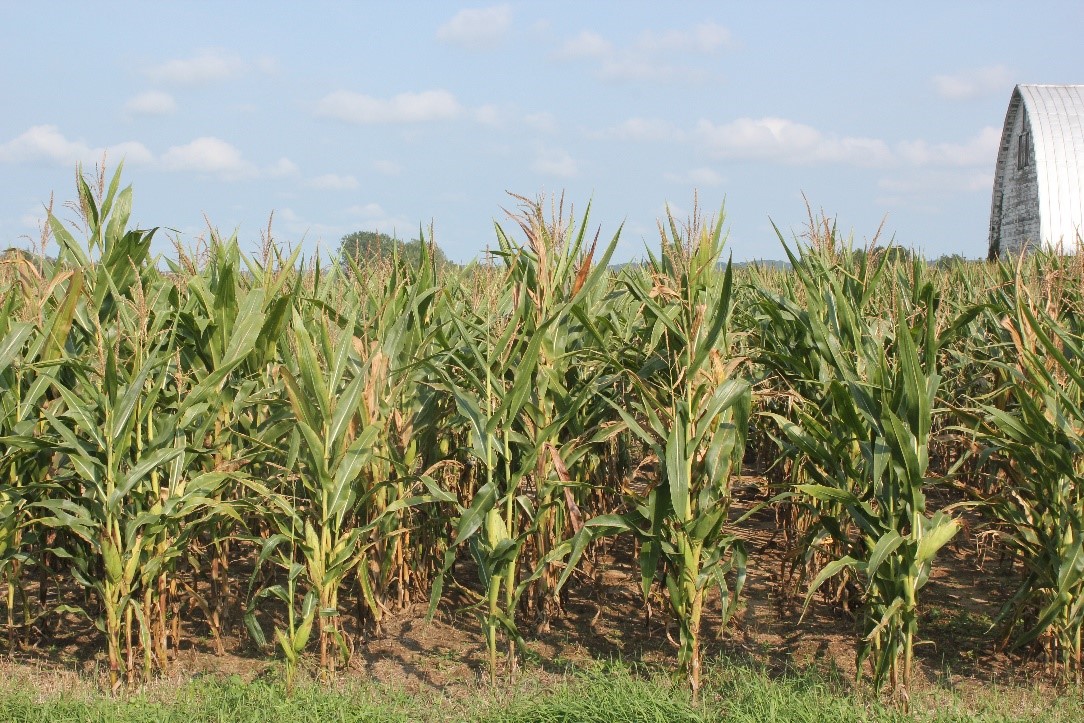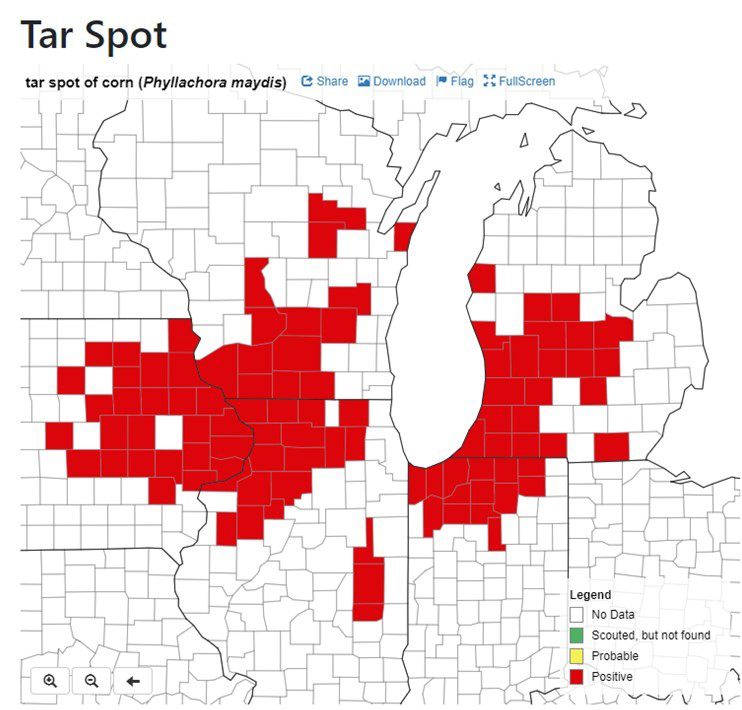Check fields for tar spot if your later-planted corn is turning every color except green
Corn tar spot symptoms are becoming more widespread across southwest Michigan.

Much of southwest Michigan saw a return to adequate soil moisture with thunderstorm-driven rainfall over the last two weeks, but along with the more favorable moisture conditions, we have also seen a virtual explosion of tar spot symptoms on dryland fields, especially in Van Buren County. These symptoms, which have been all too easy to find in irrigated corn across the region for the last two to three weeks, are beginning to become much more widespread across southwest Michigan.
Michigan State University Extension is holding a Tar Spot Field Day on Wednesday, Sept. 18, 2019, in Fennville, Michigan, to discuss disease and control options. Go to the end of the article for more information on the meeting.

Tar spot, a fungal disease caused by the pathogen Phyllachora maydis, was first found in Indiana in 2015 and became an issue in limited fields in Allegan County in 2016. It has since spread across many of the counties along the southern Lake Michigan shoreline. The initial symptoms are very inconspicuous. Dark, raised spots called stroma can be very hard to find in fields, but these sporulating bodies can pack quite a punch, producing inoculum that can quickly spread throughout a field and surrounding areas. The disease overwinters on infected corn residue, which is virtually everywhere across the region, so once the pathogen was in our area, it has been a widening threat.
Several producers I have visited with recently had not seen the disease symptoms in their fields before. We did see substantial expansion in the number of fields impacted last season, but the symptoms showed up so late that it appeared only as a bit of an early dry down in many fields, so many producers missed it. It was most commonly discovered as poor stalk strength during harvest last season.

The 2018 growing season had more moisture and a significant number of foggy mornings that stretched into early afternoon. These kinds of conditions are apparently perfect for tar spot to spread rapidly and infect plants. Irrigated fields had been infected the earliest, most likely because of the extended periods of leaf wetness in fields. With the return of the rainfall, we have been seeing more symptoms developing in corn that had been previously dry.
Leaf tissue on heavily infected plants will tend to collapse in the course of 10-14 days, perhaps slightly longer. The visible change of color we are seeing across the upper canopy of later planted corn is the beginning of this process. Corn often takes on a bit of a frosted appearance, mainly due to the tissue death in the upper leaves. Stressed areas of fields may be the first to show symptoms. Field edges have often been infected earlier and may be an indicator of issues to come.

There is nothing we can spray on the fields that are approaching R5 (early dent) that will be effective at stopping or even slowing down the disease. At this point, the best we can do is hope the plants can hold on well enough to take advantage of the much-needed heat and soil moisture we have on tap for the remainder of September. If you plan on harvesting corn infected with tar spot for silage, keep an eye on stalk moisture, which can rapidly change as the plants begin to collapse over the next couple of weeks. It may be a challenge for some of the later planted corn to fully reach the 50% milk line goal at a reasonable stalk moisture level to make good silage.
For corn grain, the largest impact on fields is likely to be reduced test weight and increased lodging. In fields that are severely impacted after R5.5 has occurred, test weight might be light, but the corn should be marketable. Fields that are more immature are likely to have more significant challenges. Planting date, the relative maturity group of the corn planted, as well as the level of incidence and severity across the entire field, will impact yield and quality. Plants that are not likely to make good grain quality should be harvested for forage if you can find a grower that can use it for feed. Tar spot, unlike some other fungal pathogens that impact corn, does not produce mycotoxins.

Lodging occurs because plants that lose leaf tissue early have less carbohydrates available to the plant for translocate to the kernels. This often forces the plants to start scavenging materials from the stalks, which can cause problems with stalk strength. Be prepared to evaluate stalk strength as we approach harvest to prioritize fields where tar spot might have compromised the plants.
Tar Spot Fungicide Plot Field Day on Sept. 18
MSU Extension field crops pathologist Martin Chilvers is holding Tar Spot Field Day on Wednesday, Sept. 18, from 2 – 5 p.m. at his tar spot fungicide research plots at 6270 116th Ave, Fennville, MI 49408. He will be talking about tar spot and showing the results of his fungicide trials in the field. This is an excellent opportunity to evaluate the effectiveness of fungicide applications used to control this disease. Register online for the Tar Spot Field Day or call the Van Buren Cunty MSU Extension office at 269-657-8213. There is no fee for the program, we would like folks to register so we can contact you about a reschedule date in case the event is rescheduled due to weather.

The return of warmer than normal temperatures has helped, but much of the later planted corn is in danger if not reaching physiological maturity before a killing frost. MSU Extension has been gathering resources to help producers to estimate if their fields are going to make black layer. This information can be found at the Delayed Planting Resources page.



 Print
Print Email
Email